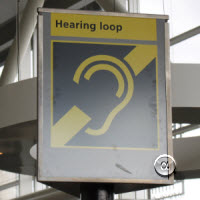Assistive Technology Is Needed To Improve Deaf People Airport Experience
- Written by Roberto Castiglioni
 Despite deafness affects five per cent of the world's population, assistive technology for the deaf is widely unavailable at most airports.
Despite deafness affects five per cent of the world's population, assistive technology for the deaf is widely unavailable at most airports.
Reduced Mobility Rights recently published study identifying critical issues with accessibility and assistance services shows that most European airports are deaf to the needs of the hearing impaired.
The imminent impact of baby boomers on ageing population is the wakeup call for the air travel industry. One-third of people over 65 years of age are affected by disabling hearing loss, and because of baby boomers, over 65s are forecast to double over the next 20 to 25 years.
Needless to say, airports must urgently take action to tackle the state of social isolation the hearing impaired
experience when traveling by air. Deafness is a significant impairment; however, deaf people normally decline assistance at airports as they do not identify their condition to disability.
The vast majority of hearing impaired passengers are happy to remain independent during their journey through airports, provided assistive technology is made available to enhance their travel experience.
There are a number of readily available, affordable assistive technology solutions that can greatly improve the airport experience for the hearing impaired and people with mild visual impairments as well as those with learning and cognitive difficulties.
Airport Navigation Signage
A basic criteria that is important for airport operators and of the essence for passengers is standardization of signage from one airport to another, enhancing passengers comfort while delivering cost efficiency through economies of scale.
Clear way finding signs are essential in the airport, a place where emotions normally run high. Texts and pictograms have to be clearly legible, easy to find and read to ensure an airport environment can be navigated independently. Passengers need consistent and accurate information when making their way in the airport to enjoy a stress free, seamless journey.
Positioning way finding signs at the right height creates the perfect balance between keeping a good viewing distance while being high enough to guarantee unobstructed view at all times.
Content readability can be enhanced by following these basic criteria. Black text on a white background is the
Assistive Technology at Check-In Desks
Clearly marked Check-In Desks equipped with assistive technology to support the needs of the hearing impaired must feature hearing loop, dedicated FIDS (Flight Information Display Systems) with video in ISL (International Sign Language) and captioned information detailing security checked luggage requirements. The desk must also feature a speech and text translator into Sign Language system.
Assistive Technology at Security Check Points and Passport Control
On queue approach there must be a clearly marked call button alerting staff that the passenger is hearing impaired, unable to communicate or needs assistance. The passenger is than directed to the station / booth featuring hearing loop, dedicated FIDS (Flight Information Display Systems) with video in ISL (International Sign Language) and captioned information detailing required actions and a speech and text translator into Sign Language system.
Assistive Technology at Departure Halls and Gates
Departure Halls and gates must be fitted with FIDS (Flight Information Display Systems) also featuring video display of verbal announcements (speech recognition technology). Modern FIDS applications allow airports to display a mix of flight information, advertising and video.
Starting this September leading advocate for access to air travel Reduced Mobility Rights will be ready to deliver a cutting edge yet cost effective turnkey solution for airport operators wishing to improve the experience of their hearing impaired guests. Airport operators are welcome to use our contact form for inquiries.










